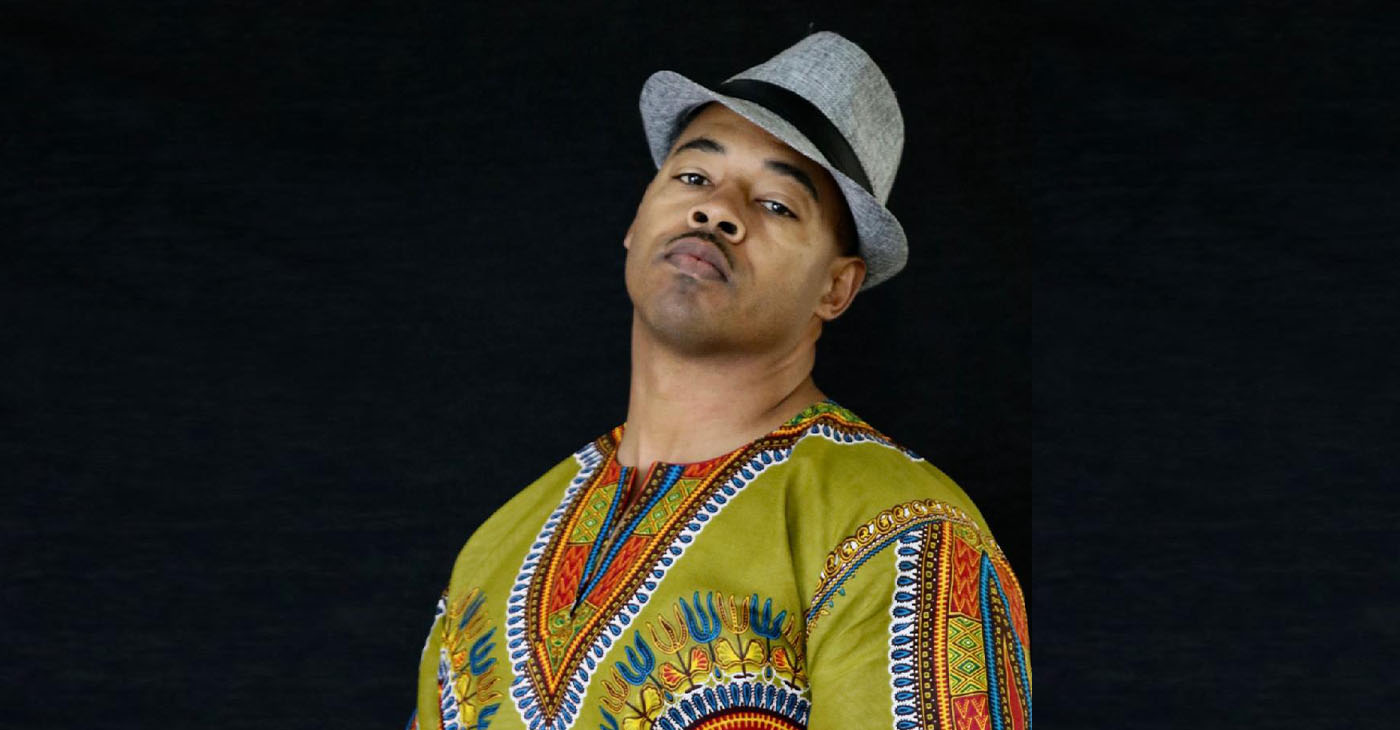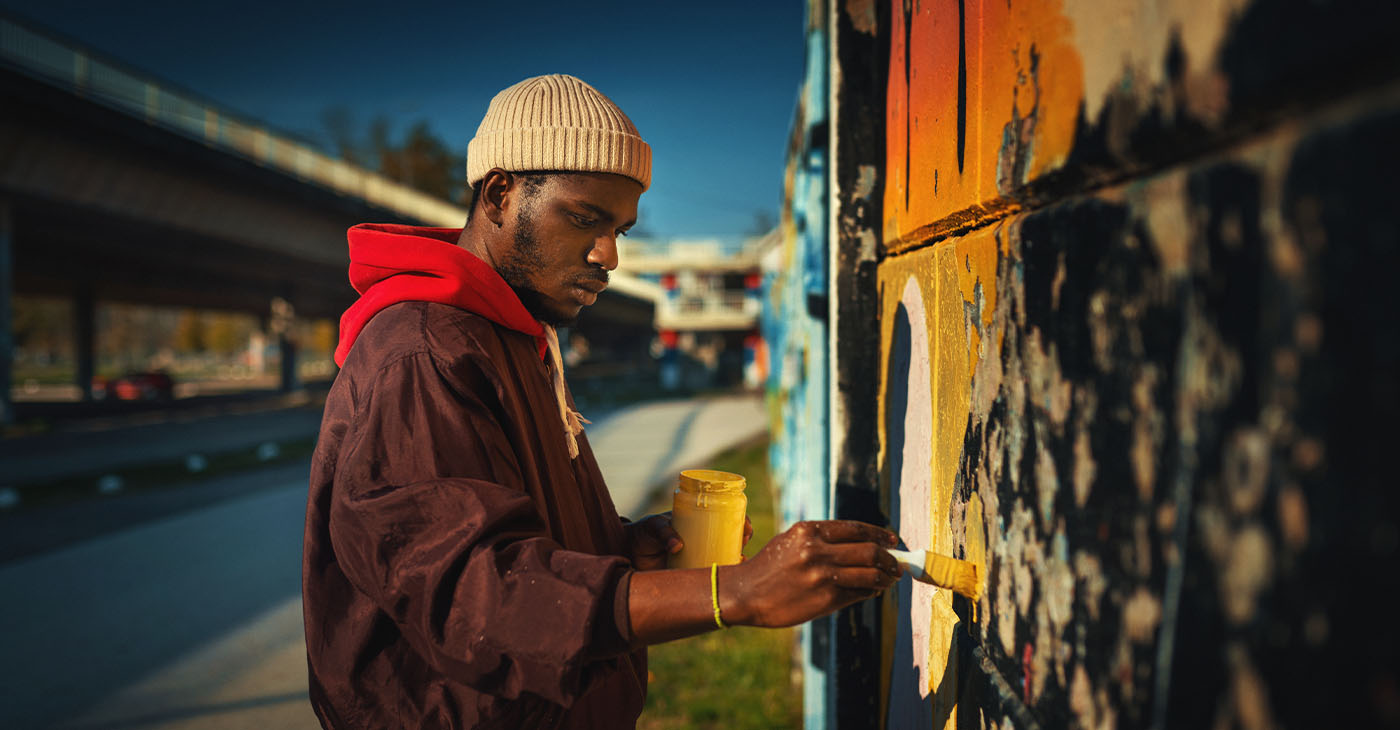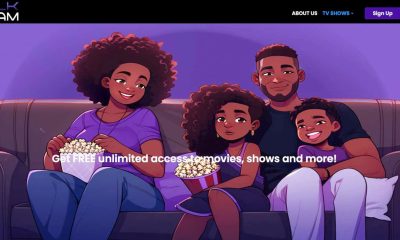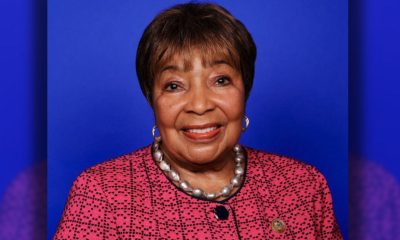Art
U.C. Berkeley Student Artist Eniola Fakile’s Work Takes on Chaos as Theme
As a Master of Fine Arts student in the Department of Art Practice, Eniola Fakile says she feels encouraged by the faculty to go further, to push herself into new depths of self-exploration. It’s something she has been compelled to do since she was a kid — to put herself and her ideas out into the world, no matter how painful it might be.

By Anne Brice | Excerpted from the Berkeley News
Eniola Fakile’s creations live in another world.
Fakile is a photographer. A performance artist. A filmmaker. A sculptor. A costume designer. She works in textiles, ready-made objects and assemblage. She’s not constrained by what has been or should be. Instead, she expands outward to see how far she can go. When an idea flashes in her mind, she imagines a new universe in which that idea, that creation, lives.
“I’m addicted to making things complicated,” she says. “I can never make something basic and easy. I like chaos of my own making because I made it.”
She builds sculptures. Some that people wear — and that she wears — and often posed meticulously. The harder the costumes are to build, the better. They might be made of fuzzy, neon-colored fabric. Or long, fluffy wigs. Or cotton balls and beads and crumpled tissue paper. Right now, she’s trying to figure out how to build a dress out of concrete — with an emphasis on the word “try,” she says.
As a Master of Fine Arts student in the Department of Art Practice, she says she feels encouraged by the faculty to go further, to push herself into new depths of self-exploration. It’s something she has been compelled to do since she was a kid — to put herself and her ideas out into the world, no matter how painful it might be.
Berkeley News spoke with Fakile about the process of creating art — “It’s 0.1% bravery and the rest is, like, I need to get it out,” she says — and how she’s learning to accept her wide-open nature, even when she doesn’t want to.
Berkeley News: Where did you grow up and what was your childhood like?
Eniola Fakile: I grew up in Stone Mountain, Georgia. I have two lovely immigrant parents who would do anything for me. My parents are from Nigeria. Even though I was born in America, the vibe in my house was like, “Don’t forget that you’re Nigerian. Don’t forget culture and family.” I’m exactly the same as how I was when I was a kid. I wasn’t the kid who everyone was like, “Oh, they’re going to be an artist.” I just did weird stuff. I liked to play outside, and I liked to talk to trees, play in the dirt. I was a bubbly kid. I cried a lot. I still do.
Have you always been interested in creating art?
I feel like I’ve always been doing art. I had an active imagination as a kid. The first time I really got into it was my freshman year of high school. My parents got me my first digital camera when I was a freshman in high school. It was this basic little point-and-shoot thing. I always had my camera with me. I was always taking photos. I took photos of my friends. I took endless photos of trees. I took photos of my feet. I took photos of my hands. I took photos of food. I just really wanted to reintroduce myself to the world through a camera lens.
As a sophomore, I took a film photography class. I fell in love with how physical of a practice it is. It’s learning how to handle things with care, working with chemicals, going out and making mistakes, going out again, making it better.
(Using herself as the ‘model,’ Fakile worked on a video series. Part of one is her exploration of what it means to be a Black woman.)
Eniola Fakile: With each video, I wanted to dig deeper, but then, I also wanted the filming to get better. So, I was trying to progress as a videomaker. I made it over a year, and during that time, I started to become more and more comfortable with myself in front of the camera, talking about these things. And I’m always trying to be really careful about how I talk about being Black in my work because the way I feel about it is complicated.
Don’t get me wrong — I love being Black. But I feel like I want to make work about being Black without being exclusionary. So, I try to make work with little markers that I know other Black people can identify with, but then also everyday things that I know other people will respond to, so that it’s work that anyone can feel connected to. But especially Black people.
So, the series is about all those things. It’s about me as a Black woman dealing with my body image issues or how to deal with my hair. But it is also about me as a person dealing with the stress of everyday life, imposter syndrome, not feeling like I’m good enough. All of those things.
Berkeley News: How do you approach creating art? Once you get an idea, where do you begin?
Eniola Fakile: Every time I start a new series of work, I buy a journal, and I write down what I want to talk about. The process involves a lot of crying. It involves watching the same things over and over again to get the design juices flowing. Like, I’ll watch New Girl over and over again. I’ll watch Cruella — love that movie. The Devil Wears Prada. There’s a show called A Discovery of Witches with a season set in Elizabethan England.
When I get an idea for a sculpture or costume or whatever you want to call them — I still don’t have a name for them — it’s like a quick flash in my mind. I’ll do a really quick, messy sketch. Then, I try my best to build it. And it changes along the way.
My ideas manifest out of everyday things, like a hamburger. I’ll think: What is a hamburger? What if that hamburger had feelings? How do I turn that into a shoe? It sounds ridiculous. It involves a lot of fantasy and imagination, and I love doing it.
See more of Fakile’s work on her website and Instagram page.
Art
Marin County: A Snapshot of California’s Black History Is on Display
The Marin County Office of Education, located at 1111 Las Gallinas Ave in San Rafael, will host the extraordinary exhibit, “The Legacy of Marin City: A California Black History Story (1942-1960),” from Feb. 1 to May 31, 2024. The interactive, historical, and immersive exhibit featuring memorabilia from Black shipyard workers who migrated from the South to the West Coast to work at the Marinship shipyard will provide an enriching experience for students and school staff. Community organizations will also be invited to tour the exhibit.

By Post Staff
The Marin County Office of Education, located at 1111 Las Gallinas Ave in San Rafael, will host the extraordinary exhibit, “The Legacy of Marin City: A California Black History Story (1942-1960),” from Feb. 1 to May 31, 2024.
The interactive, historical, and immersive exhibit featuring memorabilia from Black shipyard workers who migrated from the South to the West Coast to work at the Marinship shipyard will provide an enriching experience for students and school staff. Community organizations will also be invited to tour the exhibit.
All will have the opportunity to visit and be guided by its curator Felecia Gaston.
The exhibit will include photographs, articles and artifacts about the Black experience in Marin City from 1942 to 1960 from the Felecia Gaston Collection, the Anne T. Kent California Room Collection, The Ruth Marion and Pirkle Jones Collection, The Bancroft Library, and the Daniel Ruark Collection.
It also features contemporary original artwork by Chuck D of the Rock and Roll Hall of Fame group Public Enemy, clay sculptures by San Francisco-based artist Kaytea Petro, and art pieces made by Marin City youth in collaboration with Lynn Sondag, Associate Professor of Art at Dominican University of California.
The exhibit explores how Marin City residents endured housing inequities over the years and captures the history of plans to remove Black residents from the area after World War II. Throughout, it embodies the spirit of survival and endurance that emboldened the people who made Marin City home.
Felecia Gaston is the author of the commemorative book, ‘A Brand New Start…This is Home: The Story of World War II Marinship and the Legacy of Marin City.’ Thanks to the generous contribution of benefactors, a set of Felecia’s book will be placed in every public elementary, middle, and high school library in Marin.
In addition, educators and librarians at each school will have the opportunity to engage with Felecia in a review of best practices for utilizing the valuable primary sources within the book.
“Our goal is to provide students with the opportunity to learn from these significant and historical contributions to Marin County, California, and the United States,” said John Carroll, Marin County Superintendent of Schools.
“By engaging with Felecia’s book and then visiting the exhibit, students will be able to further connect their knowledge and gain a deeper understanding of this significant historical period,” Carroll continued.
Felecia Gaston adds, “The Marin County Office of Education’s decision to bring the Marin City Historical Traveling Exhibit and publication, ‘A Brand New Start…This is Home’ to young students is intentional and plays a substantial role in the educational world. It is imperative that our community knows the contributions of Marin City Black residents to Marin County. Our youth are best placed to lead this transformation.”
The Marin County Office of Education will host an Open House Reception of the exhibit’s debut on Feb. 1 from 4 p.m. – 6 p.m.. All school staff, educators, librarians, and community members are encouraged to attend to preview the exhibit and connect with Felecia Gaston. To contact Gaston, email MarinCityLegacy@marinschools.org
Activism
Alternative Outcome to Slayings by Police Explored in One-Man Play
BLACK MEN EVERYWHERE! is the explosive new one man play written, directed, and performed by Jinho “Piper” Ferreira. Set against the backdrop of a presidential election, the play explores how political and cultural leaders wield the myth of the dangerous Black man to manipulate the masses for personal gain. Piper penned the follow-up to his ground-breaking solo play, “Cops and Robbers,” after an impromptu cross-country Black history tour.

Special to The Post
What would happen if police officers who have gotten off for killing unarmed Black people started turning up dead?
BLACK MEN EVERYWHERE! is the explosive new one man play written, directed, and performed by Jinho “Piper” Ferreira. Set against the backdrop of a presidential election, the play explores how political and cultural leaders wield the myth of the dangerous Black man to manipulate the masses for personal gain.
Piper penned the follow-up to his ground-breaking solo play, “Cops and Robbers,” after an impromptu cross-country Black history tour.
“My wife and I had been talking about it for years,” Ferreira said. They had taken their three children to Brazil several times and West Africa but had yet to explore their history as Black people in this country. “It was Juneteenth last year and I realized we had a few weeks to make it happen, so we just jumped in the car and left” Piper said.
Three weeks later the family had seen everything from the African American Museum of History and Culture in Wash., D.C., to the phenomenally preserved Whitney Plantation in Louisiana. They’d stood outside of the balcony of the Lorraine Hotel where Dr. Martin Luther King Jr. was assassinated in Memphis, Tenn., walked across the Edmund Pettus Bridge in Selma, Ala., and paid their respects at the Africa Town cemetery – where the passengers of the Clotilda (the last known U.S. slave ship to smuggle captured Africans into this country) were buried near Mobile, Ala.
“We had the kids keep a journal of the trip and my wife and I took notes, but once we got back home, I knew I had to make the pen move,” he said.
Ferreira plays 21 characters in the 60-minute emotional roller coaster ride; personalities we all know. While brilliantly weaving in themes of revolution, treachery, and revenge, “Black Men Everywhere!” is surprisingly — more than anything else — a love story.
“I wrote the play for Black men and everyone who loves us,” Ferreira said. “The play is narrated by a sistah and performed in front of the deeply spiritual artwork of Nedra T. Williams, an Oakland priestess of Olokun. It’s called ‘Black Men Everywhere!’ but we don’t exist without the Black woman.”
For tickets, please go to: http://tinyurl.com/5dm3mhra
Art
City of Stockton Seeks Applications for Public Art Murals
The City of Stockton Arts Commission (SAC) has announced the opportunity for artist(s) and/or artist teams to apply to design and paint original artwork on City-owned property through a Public Art Mural Program. The deadline for applications is Friday, March 8, 2024, at 5 p.m. Applications and additional information are available online at www.stocktonca.gov/publicart.

City of Stockton
The City of Stockton Arts Commission (SAC) has announced the opportunity for artist(s) and/or artist teams to apply to design and paint original artwork on City-owned property through a Public Art Mural Program.
The deadline for applications is Friday, March 8, 2024, at 5 p.m. Applications and additional information are available online at www.stocktonca.gov/publicart.
The Public Art Mural Program incentivizes mural installations by providing city funding and the means of curating the City’s collection of murals.
This program has $50,000 in available funds for artist(s) and is also available for those who have already identified funds and would like to complete a mural project on city-owned property. Applications will be reviewed on a competitive basis and selected by the SAC.
To learn more about the Stockton Arts Commission (SAC) or qualifications and eligibility for Public Art Mural Program, please visit www.stocktonca.gov/publicart or call the Community Services Department at (209) 937-8206.
-

 Activism4 weeks ago
Activism4 weeks agoOakland Post: Week of March 27 – April 2, 2024
-

 #NNPA BlackPress4 weeks ago
#NNPA BlackPress4 weeks agoCOMMENTARY: D.C. Crime Bill Fails to Address Root Causes of Violence and Incarceration
-

 #NNPA BlackPress4 weeks ago
#NNPA BlackPress4 weeks agoFrom Raids to Revelations: The Dark Turn in Sean ‘Diddy’ Combs’ Saga
-

 #NNPA BlackPress4 weeks ago
#NNPA BlackPress4 weeks agoCOMMENTARY: Lady Day and The Lights!
-

 #NNPA BlackPress4 weeks ago
#NNPA BlackPress4 weeks agoMayor, City Council President React to May 31 Closing of Birmingham-Southern College
-

 #NNPA BlackPress4 weeks ago
#NNPA BlackPress4 weeks agoBaltimore Key Bridge Catastrophe: A City’s Heartbreak and a Nation’s Alarm
-

 #NNPA BlackPress4 weeks ago
#NNPA BlackPress4 weeks agoBaltimore’s Key Bridge Struck by Ship, Collapses into Water
-

 #NNPA BlackPress4 weeks ago
#NNPA BlackPress4 weeks agoBeloved Actor and Activist Louis Cameron Gossett Jr. Dies at 87





















































